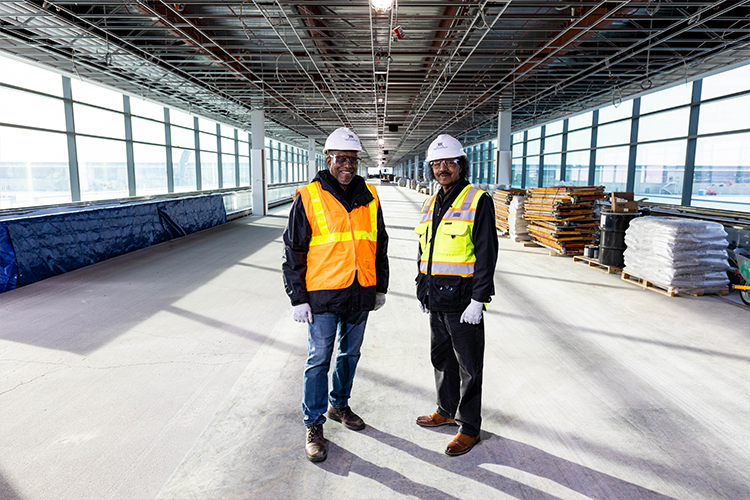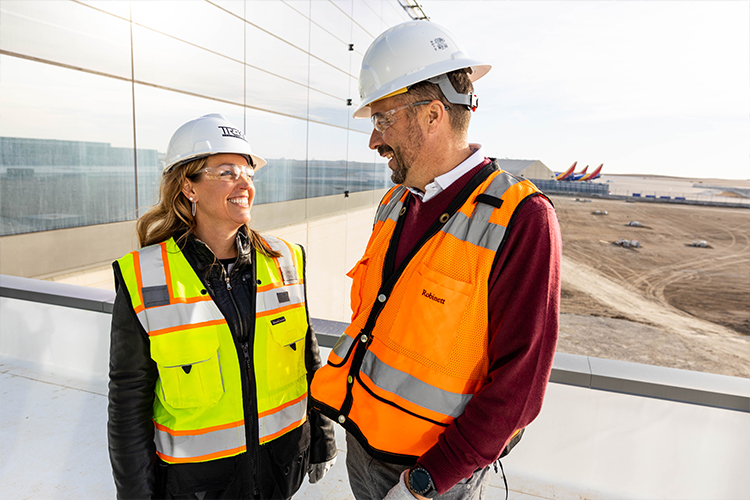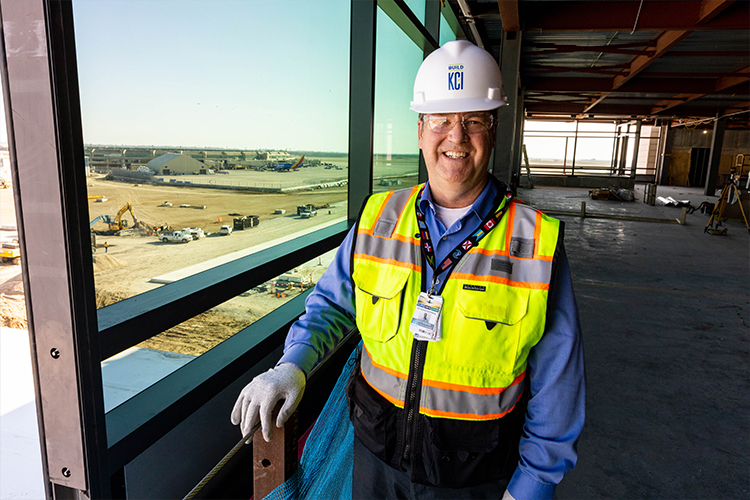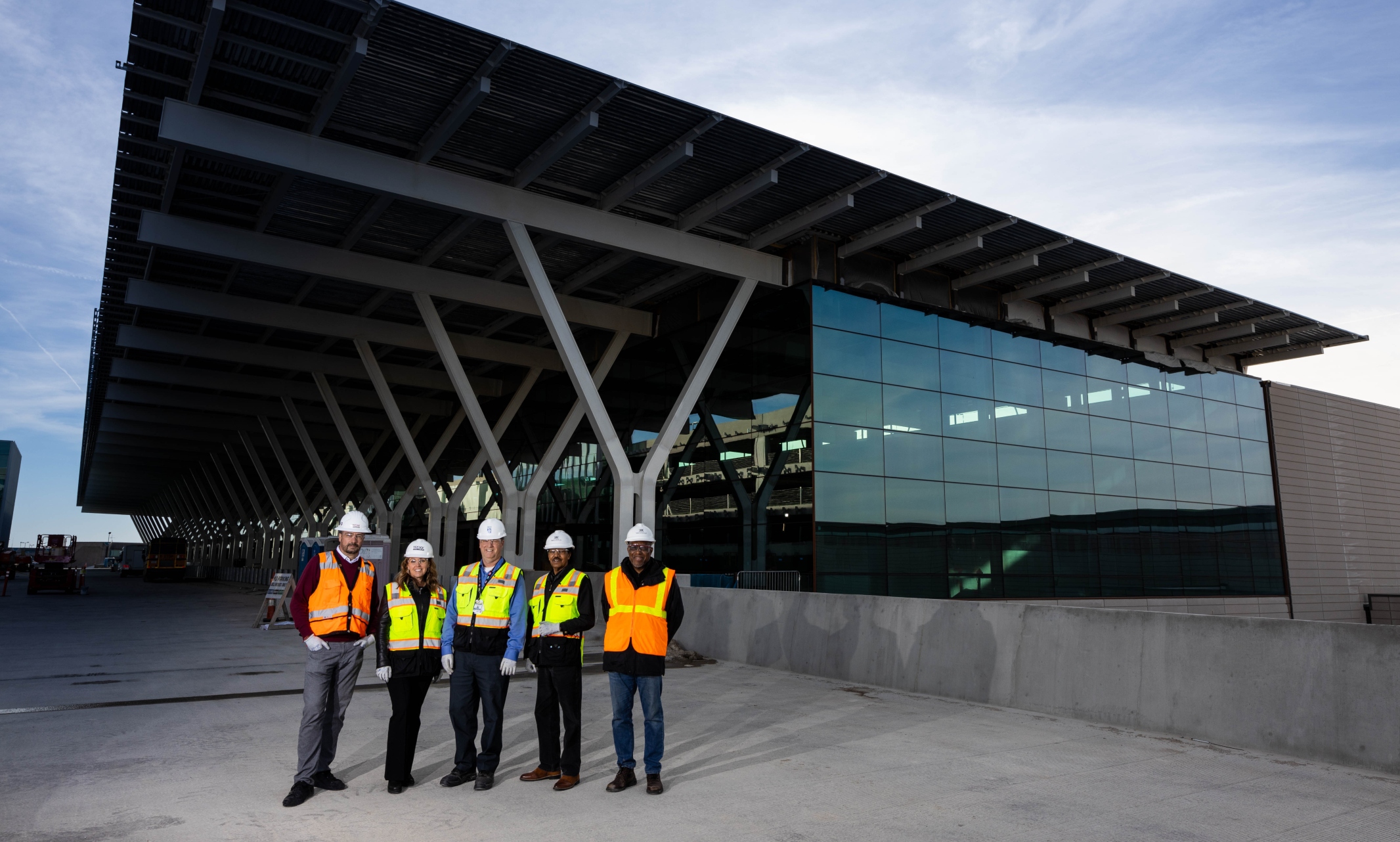Since UMKC opened its doors in 1933, Roos have been integral players in many of Kansas City’s most significant projects. So, it’s no surprise that UMKC alumni have played major roles in the design and construction of the new single terminal for Kansas City International Airport.
The $1.5 billion, one-million-square-foot structure will have 39 gates spread across two concourses. A grand opening is scheduled for March 2023.Here’s a look at some of the Roos who are playing prominent roles in the project.
Hagos Andebrhan and Leonard Graham
Taliaferro & Browne engineering and architecture firm

Taliaferro & Browne Inc. is the lead landside civil engineer for the new single terminal project, with a team of eight subconsultant companies that work under their direction and management. The engineering firm has been integral to Kansas City’s growth for more than 60 years.
Hagos Andebrhan (B.S.C.E. ’78), CEO, and his partner Leonard Graham (B.A. ’74), president, have led the company as the civil engineer of record on projects including the redevelopment of Union Station and the IRS Regional Service Center, as well as renovations of Arrowhead and Kauffman stadiums, the Kauffman
Performing Arts Center and Berkley Riverfront Park. Despite the significance of these past projects, the alumni view their role in the single terminal airport as one of their most significant.
“The new $1.5 billion KCI single terminal is a project like no other,” says Andebrhan, who received the Defying the Odds Award at the 2020 UMKC Alumni Awards, as well as the School of Computing and Engineering Alumni Achievement Award in 2012. “It is a once in a lifetime project for the city and everyone involved in its construction.”
Taliaferro & Browne Inc. was in competition with national and international firms for their role in the project.
“When Clark Weitz Clarkson, the design builder, assembled its team, they wanted a landside design team that could deliver this highly visible project on time and on budget,” Andebrhan says. “We have been part of the airport’s growth for years and were proud to be selected based on our experience.”
The firm’s specific responsibilities include project management and coordination, design of permanent roadways, including roundabouts and bridges, street and parking lot lighting, surface parking lots, utility relocation, storm and sanitary sewers, mass grading and associated project phasing. In addition, they are responsible for the design of temporary roadway connections and temporary traffic modifications required to construct the new terminal while keeping terminals B and C open and in operation — with more than 20,000 vehicles arriving and departing daily.
“It is the largest single infrastructure project in the city’s history, and the largest construction project in which our firm has lead-design responsibility,” says Graham, who received the SCE Alumni Achievement Award at the 1993 UMKC Alumni Awards. “We understood the complexities and challenges of the project, but we were excited to roll up our sleeves and get to work. The KCI new single terminal project is probably one our proudest efforts yet. We were honored to be a contributor to this significant effort."
Kimberly and Trent Robinett
TREKK Design Group

Kimberly Robinett (B.S.E.E. ‘95), CEO and managing partner of TREKK, has led the organization with an entrepreneurial spirit since she founded it with her husband and TREKK partner Trent (B.S.C.E. ’95) in 2002. Her ability to focus on delivering quality work on schedule has led to TREKK’s participation in developing the infrastructure for the new Kansas City International Airport. Kimberly is committed to the success of the project as a Kansas Citian as much as a businesswoman.
Kimberly and Trent, who shared the SCE Alumni Achievement Award in 2014, founded the company in their basement and built the organization’s culture on improving lives, rather than just the bottom line. Today TREKK has eight offices and 160 employees. Even after their participation in building T-Mobile Center, the Power and Light District, the Christopher S. “Kit” Bond Bridge, the Buck O’Neil Bridge and each phase of the Kansas City Streetcar, being involved in the KCI terminal project is significant to the Robinetts and TREKK.
“The terminal project is one of those signature projects that impacts the entire city,” Kimberly says. “It is the first thing about our city that visitors experience. But beyond that, we are hopeful that the new terminal will improve the lives of Kansas City residents by making it more attractive for airlines to add additional connections out of Kansas City.”
She sees additional air traffic in and out of Kansas City as a critical component to the city’s growth.
“Better access to this great city will encourage the recruitment of talent that will grow our local economy and have a positive impact on our neighbors, friends and families,” she says.
TREKK has held several significant roles from the beginning of the new KCI terminal. Early in the project, their team surveyed the site and located all the existing utilities.
“Our crews were challenged with untangling what looked like a bowl of spaghetti,” she says.
From there, they worked with subcontractors to design the systems that are critical to the infrastructure, including the drainage system, ground service equipment layouts and survey verification during terminal construction. These systems have a great impact on travelers, but unlike food vendors or retail, travelers are usually unaware of their existence.
Recognition for these projects has never been Kimberly’s motivation. Impacting the community has been a priority for Robinett since she and her husband started the company. But she did not envision their integral role in building the city’s corporate infrastructure.
“We never imagined that we would grow to be 160 employees in seven regions throughout the Midwest and have a large role in such significant projects that make such a positive impact,” Robinett says. “We are so grateful for the opportunities that we have had to work with leaders across Kansas City in building its future and making a meaningful contribution toward improving lives.”
While the Robinetts’ and TREKK’s success seems obvious, their most important critics and supporters are close to home. Their three daughters are proud of their parents’ contribution to the new KCI terminal.
“We traveled over the holidays, and they were very interested in the progress of the new terminal and the work we performed to contribute to that progress,” Kimberly says. “It was fun to show them the work that TREKK has been doing to help Kansas City grow.”
Joe McBride
Kansas City Aviation Department
 Even before the construction started, there was work to be done. Joe McBride (B.A. ’86), College of Arts and Sciences graduate, was tasked with facing the early obstacles in getting Kansas City’s new airport terminal off the ground.
Even before the construction started, there was work to be done. Joe McBride (B.A. ’86), College of Arts and Sciences graduate, was tasked with facing the early obstacles in getting Kansas City’s new airport terminal off the ground.
As senior manager of communications for the Kansas City Aviation Department, McBride’s job had always been to put the best possible face on the airport. Then the script was flipped.
“It was an uphill battle,” McBride recalls. “We needed to communicate the shortcomings of a facility we were used to touting as convenient.”
That was in the earliest stages of trying to assemble a community consensus about the need for a modernized terminal. Then, once a formal plan was developed for approval by the city council — to take to a public vote — the project’s champion had to silence himself. City employees are not allowed to advocate for or against specific proposals.
“When it came time for a vote, we had to stand down,” McBride says.
While more than 70 percent of voters ultimately approved the plan, McBride recalled how difficult it was in the early stages to convince people that change was necessary. The existing configuration was designed in a time of smaller planes and far less concern about airport security.
“It was outdated,” McBride recalls. After the 9/11 attacks generated the modern approach to aircraft and airport security, “We had to shoehorn security in there after the fact.”
Kansas City passengers loved the convenience of drop-offs and pickups within a few feet of the gates, but the need to make space for security screenings made the design unwieldy and impractical.
Still, the previous design had no shortage of diehard fans, and McBride’s job was to bring them around — even as he understood their passion.
“I was happy that people had a sense of ownership of it,” McBride says. “That’s good.”
The project moved to design and construction after the vote. At that point, McBride’s role morphed into the in-house consumer advocate. He monitored public comments at events, news conferences and social media. He shared what customers were saying in meetings with architects, engineers, designers and construction managers.
“We’re going to have a historical display in the connector between the concourses about the history of aviation in Kansas City and the history of the airport,” he says. “For that, I’ve been working as an editor, taking a close look at it, really diving in and taking ownership.”
And yes, his UMKC education was a factor in this success.
“At UMKC, I had a couple of great mentors and teachers, Dr. Doug Moore and Col. Robin League, both in communication studies,” McBride says. “They were sticklers for the English language. They helped me and made me a good written communicator. I continue to hear them in my head when I’m writing.”
Now he’s playing a key role in planning the terminal’s grand opening, set for early March 2023.
“I’ve talked with colleagues at other airports with new facilities about their openings, lessons learned, pandemic considerations,” McBride says. “Opening day will be a very early day after a very late night. I think after all the labor and toil it will be, ‘Wow, it’s finally here.’ And watching people come into the terminal, checking in with the wow and the awe in their eyes, that’s going to
be a fun, long, proud day.”

